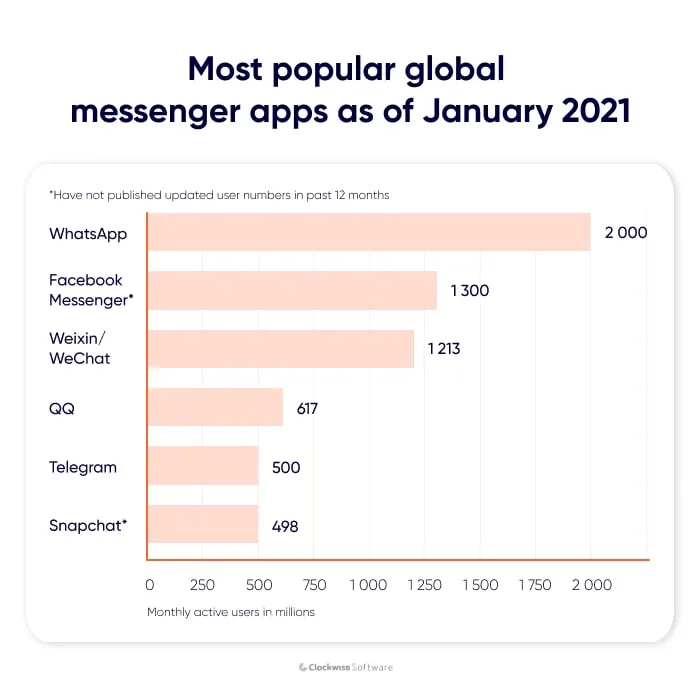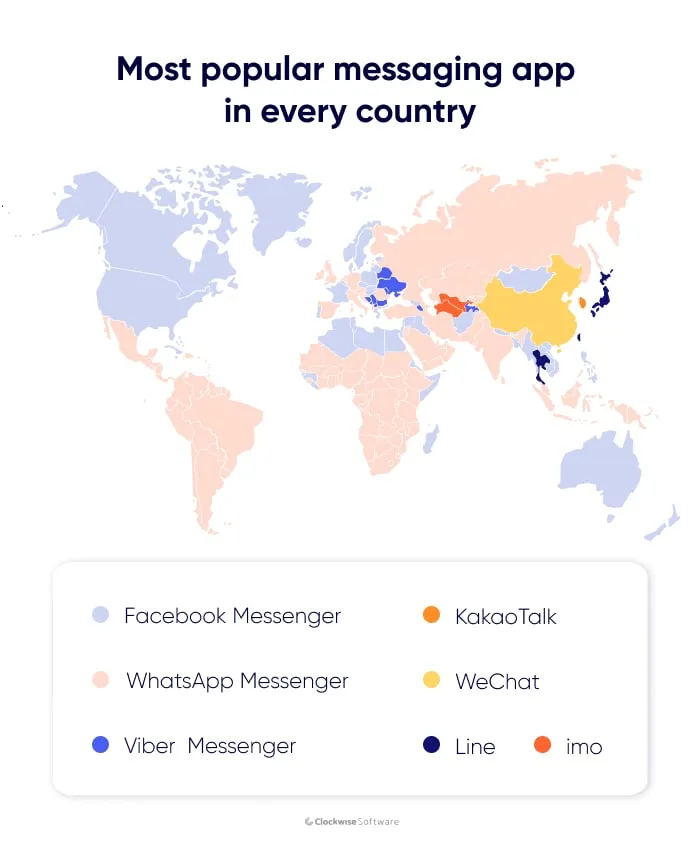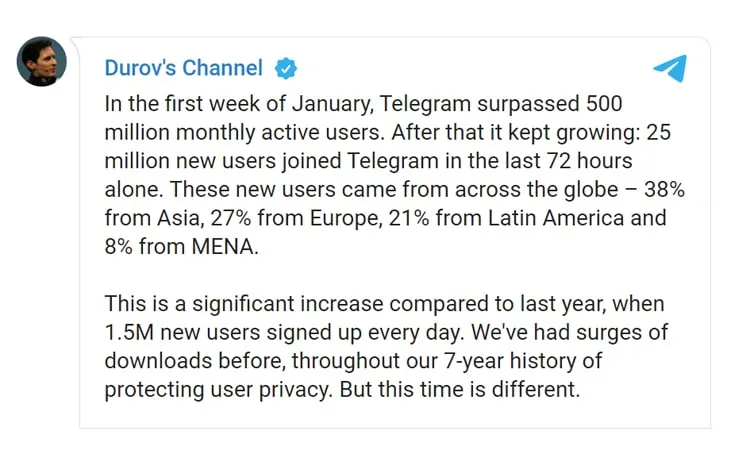What we do
Services
Experts in
Elon Musk's Twitter can set any industry on fire. In January, he posted a two-words-only tweet and drew our attention to the galaxy of messaging apps. These two words were "Use Signal," and after a couple of hours the tweet was published, the Signal messaging app was down due to an enormous number of downloads the app founders didn't expect.
This situation caused two things:
Smartphone users tried a new app willingly, with no suspicion or consideration. Even though they already use one or several popular messaging apps, they are open to a new solution; they are interested in a product safer and more user-oriented than any existing messaging app.
Have you thought about this, too?
Are you looking for ways to build a chat app, attract users and investments, and succeed?
Would you like to find out what companies lead the market and how much it cost to create a chat app?
Today, you'll find out what's going on in the market of messaging apps, why users are concerned about some of the most popular messengers, and how to build a high-quality app fast, with minimum cost.
Chat apps boom. Messengers are the most widely used sort of mobile apps, and in 2020-2021, they've been growing user bases even faster. As the COVID-19 pandemic forced social isolation, more and more people installed messaging apps to stay in touch with colleagues, family, and friends. In turn, the teams behind chat apps have been working on better design and functionality, promoting businesses via paid advertising, engaging existing users, and attracting new ones.
So what's the state of messaging in 2021?
And the number is constantly growing.
Most of the smartphone owners in the world have at least one messaging app installed on their devices. This sort of communication wins preference over phone calls and good old SMS. When most of the messengers are powered with audio and video calls functionality, standard phone calls turn to remnants of the past.
Before 2015, social media apps were absolute leaders in numbers of active users. But the tendency changed. The size of the messaging apps market surpassed social networks.
Statistics show that in 2020, users spent 20% more time on messaging apps than in 2019. And it's pretty reasonable: now, popular messengers are not just the way to communicate with other people. They are also powerful eCommerce channels where customers can find and buy needed things, ask questions, communicate with technical support, check out the latest news, or find out the details about a certain brand.
Now when offline stores have minimum to no chances to operate daily, they migrate online. Promoting business and offering products and services via messengers is quite a handy option—no need to invest thousands of dollars in setting up an online store. Manufacturers can create channels and groups in a messenger, publish their goods, and communicate with customers directly.
According to Marketing Profs, choosing between responding to an email or in a messenger, customers and clients are more likely to prefer the second option.
Either if it is a chatbot or a real person communicating via the company's messenger, customers prefer and feel more confident communicating with the support departments and brands using messengers.
Messengers are not what they used to be just a couple of years ago. Due to the number of services they provide and the way they help businesses, these apps are more than just communication channels. Instant messaging market size is worth billions of dollars, and some of the most popular apps make more than $15 of net revenue per new user.
Who are the most influential players in the market? Get acquainted with them in the next section.
The top five market leaders are WhatsApp, Facebook Messenger, WeChat, QQ, and Telegram.

Find out more about each app, its user base, revenue, pros, and cons.
Released more than 12 years ago by former Yahoo! engineers, WhatsApp is now a part of the Facebook corporation. The application delivers more than 100B messages per day, being the absolute leader almost everywhere.

Fake news, fraud, and security issues are nothing new to WhatsApp users. In 2020, even Jeff Bezos became the victim of hackers: the founder of Amazon received a message from the Saudi Arabia prince's official account that contained a malicious file.
Being such a huge messaging app, WhatsApp fails to protect user privacy and deal with security issues.
In 2014, when Messenger became a stand-alone application, Marc Zuckerberg said that messaging is one of the few things people do more than social networking. Years later, this statement is still fair. While social networks may be packed with terabytes of meaningless data and memes, messengers help focus and discuss the essential things only.
The recent technical issue made all Facebook products go down globally for about an hour. Lags, features that don't work correctly, and poor performance with low-speed Internet are typical troubles.
Now, Facebook plans to merge the back-end of its messengers (WhatsApp, Facebook Messenger & Instagram messenger) into one giant four billion users messaging app. Such a massive integration of apps with millions of users may affect data security and result in hacks and data leaks.
This is a Chinese messaging and social networking app. WeChat has so many features that it is sometimes referred to as a super app or app for everything. Users can connect to more than a billion people here, exchange text and voice messages, create and send selfie stickers, arrange video and audio calls, create daily stories, share locations, and much more.
Now, the WeChat team focuses on video sharing functionality development.
The Chinese government has access to user activity, messages, and content shared on WeChat. The transmitted data is thoroughly analyzed to improve censorship algorithms. When coronavirus started in China in 2020, the app censored all messages about it.
The app is blocked in multiple countries.
QQ is more than 20 years old. Once known as Open ICQ, it was a messaging application for desktop. The company released the Android and iOS versions in 2013.
The QQ users' accounts are a combination of numbers. The membership is temporary, so if an account is inactive for a month, it will be deactivated.
As well as WeChat, QQ is a Chinese app. Thus, all the same regulations, controversies, and censorship apply.
Besides, the app has serious security issues. According to Wikipedia, communications are not end-to-end encrypted, users can't verify contacts' identities, past messages are not secure if the encryption keys are stolen, the code is not open-source), and the security design is not properly documented.
Former VK social network founders, Nikolai and Pavel Durov, created Telegram after Russian political authorities took VK. The brothers focused on creating a completely safe user-focused app.
"We don't do deals with marketers, data miners, or government agencies. Since the day we launched in August 2013 we haven't disclosed a single byte of our users' private data to third parties."
As well as the Signal app, Musk's tweet accelerated Telegram's growth. In January 2021, the number of users grew drastically:

In practice, the situation doesn't look as good as described in blog posts. Several security breaches, controversial use reports, and censorship in multiple countries affected Telegram's reputation.
None of these apps is perfect. While these apps scale, more and more security troubles and user concerns arise.
The messaging apps market is waiting for its new hero, both strong and safe enough to compete with the leaders.
Are you planning to create a messaging app?
It's impossible to define precisely how much time you need to invest in the chat app development process. As you can see, leading apps were initially launched many years ago, but they still work on re-design, functionality upgrade, security improvement, and other engineering-related tasks.
Software development is an iterative process. It means that you don't necessarily need to invest millions of dollars and several years to bring your app to the market. You can build a simple plan, develop several significant features, roll out an app, measure results, collect users' feedback, and repeat the process.
The initial app's version will bring you first users and attract first investors.
The improved app's version will bring even more users and more funds.
With more funds, you can deliver even better functionality built with cutting-edge technologies, satisfy users' demands in a better way, and attract even more users, finances, and attention.
The initial version you probably want to start with is called MVP - a minimum viable product. MVP is your key to users' hearts and investors' money, and we can help you build it the right way.
Brian Acton and Jan Koum, WhatsApp founders, had a vision of a messenger where a status appeared next to a user's name. They incorporated WhatsApp Inc. in California long before the app was released: several initial versions of an app crashed. However, founders didn't stop working on a product and took their vision to life.
The founders had previous development experience and an idea. They acted fast and wanted their product to succeed.
What they didn't have is a defined business plan - an essential deliverable of the project discovery phase.

More than 11 years ago, their main competitor was Facebook. But if they launched WhatsApp today, they would have dozens of rivals.
Building a chat app now, you need to be aware of market leaders and young but promising startups. You should get acquainted with your potential competitors, try their products and decide how to outrun them. It is significant for your success to focus on a target audience and launch an app that meets (or will meet) their expectations precisely.
Thus, you should start with deep research, competitors' analysis, and a business plan development. The project discovery phase is the first stage of startup development. This phase will help you get answers to all business-development-related questions, prioritize must-have features, understand how much time and money you need to invest in your app, and define a strategy to win your market share.
When Facebook was launched, its design was simple and appealing. Now, it's complex, full of different elements, blocks, fields, images, and animations. But design isn't just about how an app looks; it is also about how intuitive and straightforward users may find it.
To deal with design-related tasks, you need support from a business analyst and a UI/UX designer. While BA studies users' preferences and designs of similar apps, a UI/UX specialist develops a concept of your entire brand, including color schemes, logo, icons, and fonts. Then, a BA and a designer work on app's screens and relations between them. Their efforts result in the app's prototype - the simplest version of a product you build. The prototype helps to understand whether your app is attractive, simple, and intuitive, or you need to re-design some of its elements, change the app's logic, opt for another color scheme, etc.
When you have your app's design polished, software engineers come into play. They code the MVP from scratch and convert your plan into a real responsive software product.
Check our recent article and learn more about the roles in the startup development team.
Besides software developers, software testers participate in the process, too. They check whether the features meet app requirements and make sure the application works correctly. Once they find an error, they report to software engineers, who fix it. As a result, you get a high-quality software application with no issues.
Once MVP is developed and checked, you can deploy your product and make it available as a mobile, a web-based, or a cross-platform app.
With an up and running MVP, you can start growing a user base. Remember to collect users' feedback: each review and opinion matters if you want to make a messaging app customers love. And each review may turn to an idea on your app's improvement. A business plan and an MVP give you a chance to attract investors, apply for a grant, or tell about your product on a crowdfunding platform.

More investments allow building a better product; a better product helps to raise more funds.
Following the MVP approach, you should focus on critical chat app features first. To simplify this task for you, we created this table:
| Feature | Description |
| Authorization | Allow authentication via email, phone number, or other social media profiles.You may need to use particular services called APIs, like Graph API for login via Facebook or Google API for login via Google account. |
|
User profile |
Ask for the user's name and photo, allow simple profile customization like changing background colors. |
|
Access to a contact list |
Ask the user's permission to access the contact list and import contacts to an app. |
|
Chatting |
Allow users to exchange instant messages and show the status of each message (failed/ delivered/ read.) |
|
Media files sharing |
Emojis, stickers, and GIFs may add some entertainment and gamification, while images, video, and audio file sharing may increase engagement and make users spend more time on your app. |
|
Push notifications |
Inform users about new messages. |
|
Security features |
Confirm the user's identity via two-factor authorization.Use the latest technologies for message encryption. |
| Feature | Description |
| Group chats | Allow users to communicate with more than one person in a chat. |
| Audio and video calls | Extend borders and allow voice and video calls on your platform. |
| Location-based features | Let users share their location in a group or with another user. |
| Disappearing messages | Self-destructive messages may make users feel more comfortable: delete messages on both devices within a specified time automatically. |
| Scheduling messages | When businesses join your app, they probably want to send updates about their product daily, at the defined time. Allow scheduling and help them automate work with your app. |
| Chatbots and AI features | Follow the latest trends and allow chatbots on your app. |
Note: this is not the one-fits-all list of features for the messaging app. Your product is unique, so implement special features in it. Besides, during each iteration, remember to improve existing functionality, fix bugs, and add features users want on the fly.
For example, you raised funds with your MVP and plan to integrate location-based APIs. At the same time, users' feedback shows that they demand audio-based functionality like in Clubhouse. You see the demand, and you know that Clubhouse is on fire, and you may lose your audience if you don't meet their needs now.
Prioritize audio-based features, announce upcoming updates and make sure you meet the pain before users leave.
Although influential leaders like Facebook Messenger and WhatsApp lead the messaging apps market, there is a massive gap for a new player. Aware of popular apps' mistakes, you may launch a better app and meet users' needs with a high-quality startup.
It is impossible to precisely estimate the time and cost you need to invest to make a chat app. But we analyzed our previous projects and gathered essential data in the table below:
Startup MVP development
|
Startup MVP development |
||
|
Stage |
Approximate time |
Approximate cost |
|
Project discovery |
3-4 weeks |
$5,000+ |
|
Prototype development |
1,000+ hours |
$50,000+ |
|
MVP development |
1,500+ hours |
$75,000+ |
